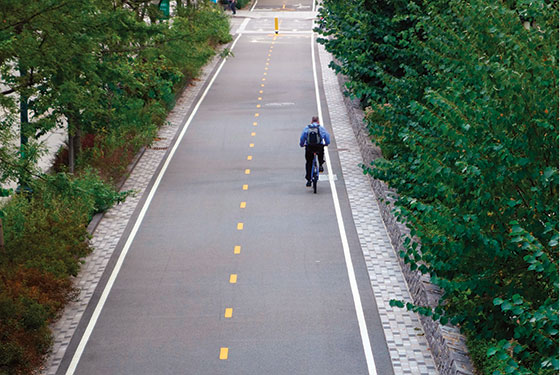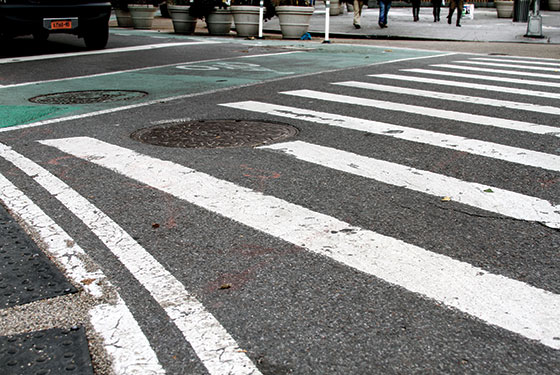
“Give me the streets of Manhattan!” Walt Whitman demanded, and he had them—miles and miles of crowded, chaotic alleys and avenues, patchily paved with cobbles, wood blocks, or gravel or simply covered in dirt. Whitman waded joyously into foaming currents of traffic, and maybe the risk of being crushed to death by a wagon or a streetcar was part of the lyric thrill. A century and a half later, the sociologist William Helmreich strolled nearly every block in New York City—6,000 miles—on streets that have been designed and redesigned for the complex choreography of striding, rolling, biking, shuffling, and driving. Helmreich doesn’t focus on the surface beneath his soles in his book The New York Nobody Knows, but his, and everyone’s, experience of getting around the city is inflected by a vast menu of design details.
The next time you cross the street, watch where you’re going. Look closely at the symphony of signs and crosswalks, bollards, lanes, and dotted lines. The sidewalk dips gently to the roadbed to let a wheelchair pass, the transition marked with a panel of bumps that catch a blind person’s cane. A few strategically placed blocks of granite guide traffic around a pedestrian plaza. Sidewalks reach out to meet the crosswalk, shortening the trip from curb to curb. A row of parked cars divides a bike lane from moving traffic. A strategically placed bench gives a parent a place to stop and tie the children’s shoes.
These features are subliminal signals that the streets belong to all of us, not just frustrated drivers in two-ton steel shells, bent on beating everyone to the next red light. They’re the work of the Department of Transportation, whose outgoing head, Janette Sadik-Khan, turned an agency devoted to painting bridges and fixing potholes into a platform for social activism. Sadik-Khan’s DOT recently released a valedictory document called, unpoetically, “Sustainable Streets: 2013 and Beyond.” It’s a data-filled report from a technocratic administration that proudly lists dangers identified, solutions implemented, results tracked. “Since 2004, the number of annual traffic deaths has been lower than 1910 levels,” it crows. “In 2011 there were 246 fatalities, an all-time record annual low.” (Far from low enough.)
The report is also a manifesto full of moral urgency. Making New York’s public spaces safe, civilized, and navigable is a deeply democratic issue. If you think that the new street designs are just about giving spandex-encased bikers a high-speed lane of their own or providing tourists with café tables and Wi-Fi, then try shepherding a gaggle of preschoolers across a complicated intersection or pushing a walker across Broadway. You’ll be grateful for every arcane bit of traffic engineering. Once-terrifying journeys have become more tranquil, not just in Manhattan’s glittering Zip Codes but in every borough. Being a flâneur in New York remains as intellectually invigorating as ever; it’s just no longer an extreme sport.
Sadik-Khan’s bureaucratic adieu doubles as a plea to the next administration: Hang tough. There were worrying signs during the campaign and afterward, when Bill de Blasio voiced lukewarm support for bike lanes and claimed that “the jury’s out” on whether the pedestrianization of Times Square was a good idea—this as crews were already jackhammering up asphalt to enshrine a wildly successful experiment. On the other hand, he has signed on to Vision Zero, a comprehensive international philosophy that adjusts streets to human behavior rather than forcing people to comply with abstract planning principles of efficiency. De Blasio and his police commissioner–designate, William Bratton, have also promised to do for traffic deaths what previous administrations did for murder: minimize the plague. Watch those 1910 records recede in the rearview mirror.

The project of reforming New York’s streets is nowhere near complete. Select Bus Service is in its infancy and needs to be radically extended. So does the Citibike system. Permeable paving can absorb rainwater and make crossing the street after a storm a less amphibious adventure. And we still need to find a way for the various ways of getting around the city to coexist more peaceably. Cycling rates have risen and the Citibike system is a success, but we still have an adversarial atmosphere in which riders, drivers, and pedestrians act as if they belong to different tribes. This is still a city full of Ratso Rizzos yelling, “I’m walkin’ here!”
Continuing the job will take commitment and the continued pressure of advocacy groups like Transportation Alternatives. Many of Sadik-Khan’s interventions have been quick and cheap, requiring little more than a few hours and a can of paint. Meanwhile, the DOT’s traditional responsibilities keep sponging up money: In the next decade, we’ll need to spend $4.3 billion to keep bridges in good repair, $2.4 billion for roadway maintenance, $300 million for the Staten Island Ferry. Faced with the staggering cost of covering basics, the next administration may be tempted to forget the frills. That would be a terrible mistake, because it’s those background tweaks that improve life for everyone in the most democratic part of the city: its streets.
